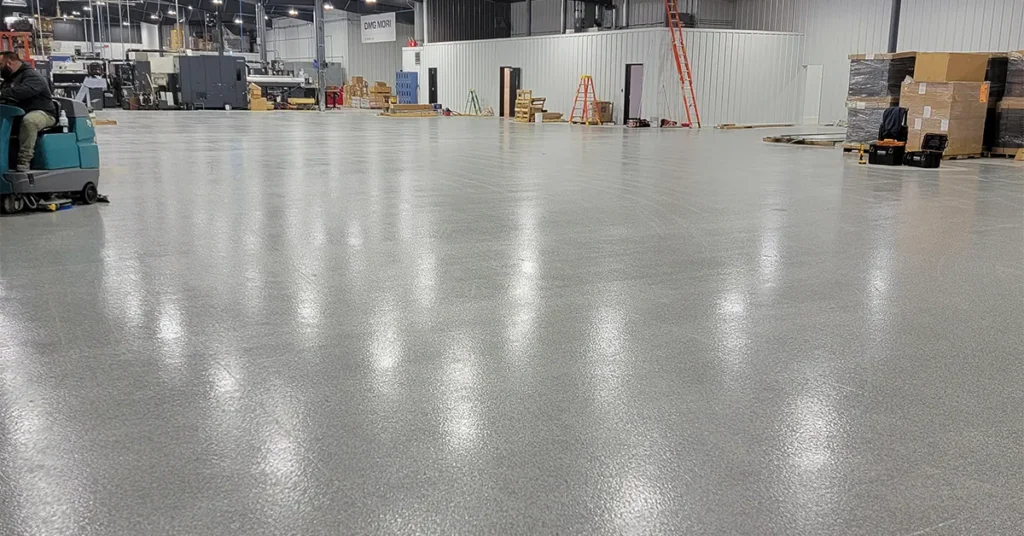Epoxy is one of the most durable, versatile, and popular materials used for flooring, crafts, and industrial coatings. Whether you’re coating a garage floor, building furniture, or doing a DIY resin art project, one question always comes up: how long does epoxy take to dry?
The drying and curing time of epoxy depends on several factors, such as the type of epoxy, temperature, humidity, and the thickness of the layer applied. In this detailed guide, we’ll break down exactly how long epoxy takes to dry, how to make it cure faster, and what to avoid to ensure a smooth, flawless finish.
Understanding Epoxy Drying vs. Curing
Before we talk about drying times, it’s important to clarify the difference between drying and curing, two terms that are often used interchangeably but mean very different things in the world of epoxy.
- Drying refers to when the epoxy becomes hard to the touch. You can gently touch the surface without it feeling sticky or tacky.
- Curing, on the other hand, means the epoxy has reached its full strength and chemical resistance. Even though it may feel dry earlier, it’s not fully cured until the chemical reaction between the resin and hardener is complete.
So when people ask, “How long does epoxy take to dry?”, they’re often referring to the time it takes to be dry to the touch, but for practical use, it’s essential to consider curing time as well.
How Long Does Epoxy Take to Dry?
Epoxy can dry faster or slower based on various factors. Here’s a breakdown of what to expect:
- Dry to the touch: Most standard epoxies will be dry to the touch within 6 to 12 hours. This means you can gently touch the surface without any sticky residue.
- Walk-on time: If you’re applying epoxy to a floor or surface, it’s generally safe to walk on it after about 24 hours, though this can vary based on the product used. However, waiting up to 72 hours is advised for full durability to ensure a long-lasting finish.
- Full cure: While epoxy may feel dry to the touch within a day, full curing can take anywhere from 72 hours to 7 days, depending on thickness, temperature, and other environmental factors. It’s essential to avoid heavy usage.
Factors That Affect Epoxy Drying Time
Temperature
Epoxy curing is a chemical reaction, and temperature plays a huge role in how fast it happens.
- Warm temperatures (75°F to 85°F / 24°C to 29°C): Epoxy dries faster and cures efficiently.
- Cold temperatures (below 60°F / 15°C): Epoxy may take 2–3 times longer to dry or may even fail to cure properly.
If you’re working in a cold garage or basement, consider using a space heater or heat lamp to maintain optimal curing conditions.
Humidity
High humidity can slow down epoxy drying and may cause surface imperfections like cloudiness or blushing. Always check the weather conditions before applying epoxy, ideally, humidity should be below 60%.
Thickness of the Pour
The thicker the epoxy layer, the longer it takes to dry and cure.
- A thin coat (1/16 inch or less) may dry within a few hours.
- A deep pour (1 inch or more) can take several days to fully harden.
In deep resin projects or river tables, it’s best to pour in multiple layers, letting each layer partially cure before adding the next.
Mixing Ratio
Epoxy resin and hardener must be mixed in the correct ratio (usually 1:1 or 2:1). Too much of either component can alter the chemical balance, leading to sticky or soft spots that never fully dry.
Always mix thoroughly for at least 2–3 minutes, scraping the sides and bottom of the container to ensure consistency.
Ventilation
Proper air circulation can help speed up drying by allowing heat to dissipate and solvents to evaporate more evenly. However, avoid strong fans directly over fresh epoxy, it can cause dust to settle on the surface.
How to Make Epoxy Dry Faster
If you’re short on time and wondering how to make epoxy dry faster, here are some proven techniques:
- Increase room temperature: Keep the workspace between 75–85°F (24–29°C) for faster curing.
- Use fast-curing epoxy: Many brands offer quick-set or 5-minute epoxy options for smaller projects.
- Apply thin layers: Multiple thin coats cure faster than one thick pour.
- Ensure proper mixing: Always mix resin and hardener thoroughly.
- Use a heat gun or lamp carefully: Gentle heat can accelerate curing, but avoid overheating, which can cause bubbles or yellowing.
Remember, rushing the process can sometimes do more harm than good, so balance speed with safety and surface quality.
Common Epoxy Drying Problems (and How to Fix Them)
Even when you follow the instructions, epoxy doesn’t always dry perfectly. Here are some common issues and how to solve them:
Sticky or Soft Surface
- Cause: Incorrect mix ratio or incomplete mixing.
- Fix: Sand off the tacky layer and apply a properly mixed coat on top.
Cloudy Finish
- Cause: High humidity or moisture contamination.
- Fix: Apply epoxy in a controlled environment and consider using a dehumidifier.
Bubbles in the Surface
- Cause: Air trapped during mixing or application.
- Fix: Use a heat gun or torch to gently remove bubbles after pouring.
Uneven Curing
- Cause: Uneven thickness or poor ventilation.
- Fix: Level the surface and ensure consistent airflow around the workspace.
When Is Epoxy Fully Cured?
As mentioned earlier, epoxy may feel dry to the touch after 12–24 hours, but that doesn’t mean it’s ready for heavy use.
The curing phase is when epoxy achieves its full strength, hardness, and chemical resistance. For floor coatings, this can take 5–7 days. For smaller craft projects, full cure usually happens within 72 hours.
During this time, avoid:
- Placing heavy objects on the surface
- Exposing the epoxy to water, oil, or harsh chemicals
- Applying additional coats too soon
Once it’s fully cured, your epoxy surface will be durable, glossy, and ready to handle heavy use for years to come.
Best Practices for Applying Epoxy
To get the best results, follow these simple but crucial tips:
- Always measure accurately, and use separate containers for resin and hardener.
- Mix slowly to avoid introducing air bubbles.
- Use clean, dry surfaces for application.
- Allow proper curing time before sanding, recoating, or placing objects.
- Store leftover resin and hardener in a cool, dry place.
These small steps can dramatically improve your final results and ensure your epoxy dries evenly every time.
FAQs
How long does epoxy take to dry before you can walk on it?
Most standard floor epoxies are safe to walk on after 24 hours, but for full durability and chemical resistance, you should wait 72 hours or longer.
How long does it take for epoxy to dry completely?
Epoxy becomes dry to the touch in 6–12 hours, but it takes 3–7 days to fully cure, depending on temperature, humidity, and thickness.
Can I speed up the epoxy drying process?
Yes, by keeping the room warm (75–85°F), using fast-curing resin, or applying thinner layers. However, avoid overheating as it can cause bubbling or yellowing.
Why is my epoxy still sticky after 24 hours?
A sticky surface usually means the resin and hardener were not mixed properly or the ratio was off. The best fix is to scrape off the tacky layer, sand lightly, and reapply a correctly mixed coat.
How can I tell if epoxy is fully cured?
When epoxy reaches its maximum hardness, feels cool to the touch, and no longer emits any chemical odor, it’s fully cured. You can also check the product label for manufacturer-specific curing times.
Conclusion
So, how long does epoxy take to dry? In most cases, epoxy will be dry to the touch in 6–12 hours, ready for light use in 24 hours, and fully cured within 72 hours to 7 days, depending on the product and conditions.
By maintaining the right temperature, humidity, and mixing ratio, you can achieve a smooth, durable, and professional-looking finish every time.
Whether you’re coating your garage floor or crafting a resin masterpiece, patience and precision are key. Let your epoxy dry and cure completely; the result will be a surface that looks stunning and lasts for years to come.


